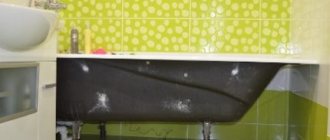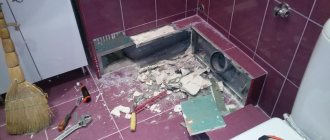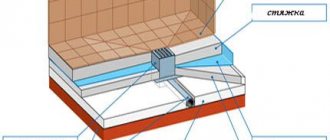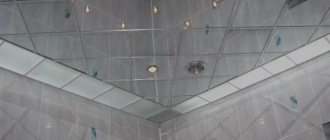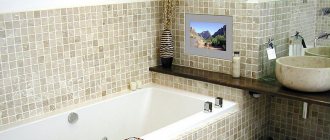To independently glue a corner in the bathroom to seal the gap between the tiles and the side of the plumbing, you need to take into account several factors. The industry produces bathtub curbs from different materials with different installation methods. The appearance of a gap between the plumbing fixtures and the enclosing structures of the bathroom can be avoided even at the stage of laying the tiles. Or seal it with special compounds without using skirting boards or border tape.
Convincing advantages
A corner for a bathtub is considered by professionals to be the best solution to the problem, much more effective than traditional putty.
- Installing the plinth is quite simple to do. Anyone can handle the installation, even those without relevant experience.
- All types of bathroom corners offered by the industry are resistant to all influences that can affect them: humidity, temperature changes, ingress of relatively aggressive substances.
- It is easy to care for any of the bathtub corners: they are made of materials that can be easily cleaned of dirt with the simplest detergents and cleaning agents.
- Bathroom corners are reliable and will last you a long time.
An additional bonus when installing such a border will be the finished appearance of the bathroom.
Curbs make the bathroom more elegant
Please note that bathroom corners are available in different types and designs. You have the opportunity to choose a border option that will ideally match the overall design of the room, fit within your budget and not force you to turn to repairmen for help.
How to properly glue the baseboard
Gluing the baseboard to the bathroom, ceiling or floor is practically no different in technology. The main fastening should be to the wall. This will ensure the required level of sealing of the hole.
Most technical curbs have a seal and are easy to install, so they can be installed without problems.
How to install a plastic baguette
Plastic products can be easily cut into separate parts and glued using a special adhesive. The working surface must first be cleaned of dirt. Blow the base with a hairdryer to dry the surface. Next, the gaps are filled with glue from the selected composition. After this, the baseboard is applied. The structure dries in about a day. At this time, direct contact with water should be avoided.
If the choice of baseboards for the bathroom has been determined, you can proceed to the preparatory work.
How to make a ceramic fillet
The surface is pre-prepared using the method described above. First, the sealant is applied using a spatula. Time is given to harden. The border should be applied to the treated surface, having previously been treated with an adhesive composition. The border must be attached to the wall. Freezing occurs within a day. After this, it is necessary to rinse the product from any remaining working substances.
You can improve the tightness of the junction by filling the gap between the wall and the side of the bathtub with sealed glue.
Self-adhesive borders
The simplest corner for a bathtub is a tape equipped with an adhesive layer. Its installation is simple, which is why many home craftsmen prefer this type of bath skirting board.
Installation can be divided into the following stages.
- Calculation works. The joint between the bathtub itself and the bathroom wall is measured. The width of the gap is determined.
- The joint is cleaned of dust and degreased.
- Surfaces are thoroughly dried. To speed up the process, you can use a hair dryer.
- If the gap is large (3 mm or more), the tape corner is mounted on the bathtub only after filling the gap with sealant. Mandatory clarification: the sealant must be neutral. Acid-based silicones are strictly prohibited, as they will subsequently corrode the baseboard.
- The tape is cut into pieces of measured length plus 2-3 cm of margin.
- Pasting is carried out starting from the long side. The protective layer from the curb is removed gradually so that the adhesive layer does not have time to dry.
- In the corners the strip overlaps. The excess is cut off with a stationery knife upon completion of installation.
When installing, do not tighten the tape. It is not recommended to use a hairdryer during the gluing process: the baseboard begins to stretch. The final touch of the installation will be to seal the corner joints with sealant and check the contour as a whole. If somewhere the fit is considered not tight enough, these places are additionally strengthened with the same sealant.
You can use the bathtub no earlier than 4 hours after installation. If the room is humid, it is better to wait longer.
Self-adhesive plinth in packaged condition
The process of installing a border tape is extremely simple
Manufacturers and prices
Today you can purchase ceramic plinths at any hardware store. Leroy Merlin offers products from the following manufacturers:
- Aparici - price 120 rubles per m2.
In the photo - ceramic baseboard for the Aparici bathroom - Atlas Concorde – price 78 rubles per m2.
- Exagres – price 220 rubles per m2.
In the photo - ceramic baseboard for the Exagres bathroom - FAP Ceramiche - price 135 rubles per m2.
- Infinity - price 175 rubles per m2.
- Italon – price 150 rubles per m2.
- Kerama Marazzi - price 106 rubles per m2.
- Mayor Ceramica - price 350 rubles per m2.
- Navarti – price 230 rubles per m2.
A ceramic baseboard for a bathroom is an excellent opportunity to give the room an aesthetic appearance and protect it from the penetration of fungi and mold. The process of installing a ceramic product is distinguished by its simplicity and ease; the main thing is to choose high-quality glue that would not lose its properties during operation. And if you are serious about renovation, it is useful to read about MDF floor skirting boards.
About plastic corners for the bathroom
The strip plinth is quite modest in appearance and is not suitable for all owners as a border. Plastic corners are the most popular. They are made from polyvinyl chloride, which is considered an ideal material for the manufacture of products that are intended to be used in conditions of high humidity. The plastic corner has several significant advantages.
- Wide color range. You can easily choose a border to match any bathroom decor, make it a key design element, or beautifully fit it into an existing harmony.
- Good flexibility. This characteristic makes it possible to install a protective skirting board even on a bathtub with a non-standard configuration.
- Affordable price. A plastic corner will cost more than a tape corner, but not so much as to force the average consumer to save up to purchase it.
At the same time, gluing the product is simple, the border tolerates temperature fluctuations indifferently, is not afraid of moisture, does not become infected with fungus, and is highly resistant to acids and alkalis included in cleaning products.
The only drawback of plastic skirting boards is their loss of appearance, which inevitably comes with time. The surface may become scratched, and some types of corners may turn yellow. However, this minus is relative: the low price and ease of installation allow you to replace the curb at any time. If the plastic corner is installed correctly, is not subjected to special physical influences, and is properly cared for, the product can serve the owners of the house for 4-5 years.
Plastic corners are divided into three classes according to their configuration:
- cast molding;
- plinth “swallow”;
- a composite type of corner.
This is what a molding type border looks like
This plastic plinth is called “swallow”
Compound corner
Any of the options can be fixed either to tiles or to any other wall finish.
What glue to choose for gluing skirting boards
The most commonly used glue is silicone. This composition is susceptible to mold over time. To avoid this, it is recommended to use special disinfectants.
Aquarium glue can be used as an adhesive to avoid the formation of fungus or mold.
Note! Some sealants are unable to provide high-quality adherence to baseboards. As a result, they begin to move away from the walls. To solve the problem, polymer compounds that have the necessary elasticity are used. Glue only the part that is adjacent to the wall.
Installation rules
The beginning of installation is the same as when using strip plinth: the tiles on the wall are washed, degreased, and dried. The same work is carried out with the edge of the bathtub, on which the plastic border will be mounted. If the gap is wide, it should be filled with cement or sealant and wait until the filler dries completely. Further actions will be as follows.
- The edge of the tile and the edge of the plumbing fixtures are taped with masking tape. This is necessary to ensure that the finishing material and the bath itself are not contaminated with glue or sealant.
- A plastic corner is applied to the joint; The required length is marked, after which the required fragment is cut off.
You can make a corner with a precise cut
- A layer of glue is applied to the junction of the bathtub and the wall. What composition to use is a matter for the master. You can also buy special adhesives, but practice shows that inexpensive and reliable “liquid nails” do the job perfectly. Please note: if the purchased border has been stored for a relatively long time, it may be necessary to clean and degrease the inside of the border before applying the composition.
The glue is applied evenly to the joint
- The corner is pressed evenly and tightly against the surfaces and held for some time to set. The required time period is specified in the instructions for the glue.
The corner is pressed to the desired area
- Excess composition squeezed out from under the fixed element is immediately removed. In about a third of an hour, it can be easily removed with a knife or a special tool.
Excess sealant is removed immediately
- Upon completion of installation, the tightness of the circuit is checked. Even small cracks should be filled with transparent sealant. Lastly, the construction tape is dismantled and the remaining working mixtures are removed (if you did not notice them in time).
The plastic border can also be joined using precise trimming. But corners decorated with fittings look more aesthetically pleasing, and it is better to cover the ends of the border with caps.
The junction of corners with the help of fittings looks more elegant
